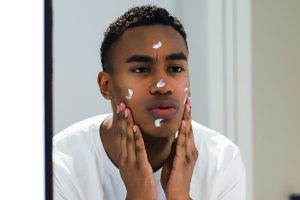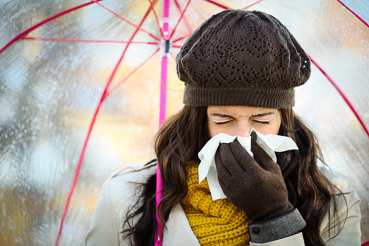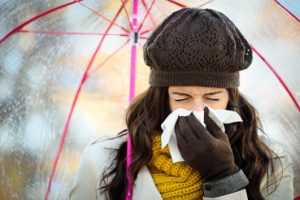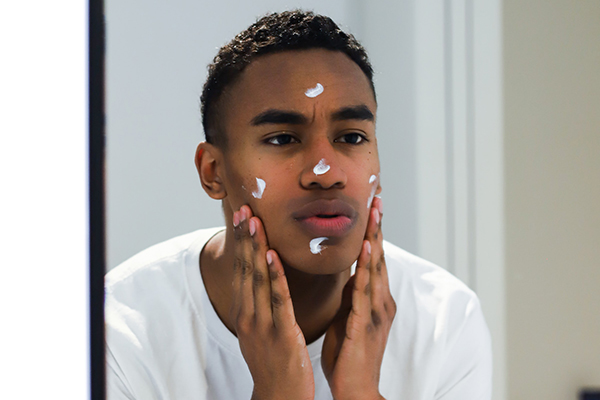A sniffle, a sneeze
PacMed doctor explains the differences between the common cold and flu virus
It’s that time of year once again — sniffles and sneezes galore, cherry-tipped noses running at a constant pace, stomach bugs the culprit behind bedroom confinement and misery. As people navigate the trenches of winter illnesses, getting a proper diagnosis is imperative for adequate healing. Here, Pacific Medical Center’s Dr. Dimple Sahay explains the distinction between the flu virus and the common cold, and offers wisdom for recovery that will leave even the most agonized victims with pep in their step.
This time of year, various illnesses are running rampant. Can you inform readers on how to differentiate between colds and the flu?
Both colds and flus are caused by viruses. While there are hundreds of viruses that can cause colds, the flu is mainly caused by influenza A and influenza B. Symptoms can overlap for both, but colds are generally milder than flus and don’t lead to serious complications. The flu is sudden in onset and has several associated symptoms including fever, chills, extreme fatigue and body aches. Colds have a gradual onset and involve upper respiratory symptoms including runny nose, nasal congestion, sore throat and sneezing — but typically no high fever, chills or extreme fatigue.
What symptoms should people be on the lookout for that may indicate the flu virus has been caught?
Flu symptoms include sudden onset of fever, chills, body aches, headaches and fatigue. People with the flu can also experience a loss of appetite, sore throat, runny nose and a cough. In some cases, people may develop gastrointestinal (GI) symptoms such as vomiting or diarrhea. It’s important to note the flu can lead to serious complications like pneumonia, bacterial infections and hospitalizations, especially in high-risk populations such as the elderly, immunocompromised, pregnant women and children under the age of 2.
What precautions can people take to avoid or lessen the severity of the flu and colds this season?
The Centers for Disease Control (CDC) recommends an annual flu vaccine for everyone 6 months and older. People should also take certain general precautions like frequent hand washing, covering your mouth and nose while coughing, sneezing with tissues and disposing it properly and cleaning your hands with alcohol rub afterward. It’s also important to wipe down surfaces such as doorknobs, toys and computers to prevent spreading germs. If flu symptoms develop, it’s recommended to stay away from work, school or other public places until you are fever-free without using fever-reducing medications for at least 24 hours. Antiviral drugs should be taken within 48 hours of an onset of symptoms to help decrease the severity and duration of symptoms.
Time is of the essence for military members and their hectic lifestyle. Do you have any tips for initiating a speedy recovery from seasonal ailments?
Once flu symptoms are recognized, I recommend to patients to rest and stay hydrated. When sick with the flu, people should stay away from work and school until their symptoms of fever and chills resolve. Residual symptoms of weakness, fatigue and respiratory symptoms may take up to one to two weeks to disappear. I also recommend taking over-the-counter fever-reducing agents for fever and discomfort. As I previously mentioned, taking antiviral medications within 48 hours of an onset of symptoms can also be key in decreasing the severity of symptoms, especially for those in a high-risk population.
How to help clear up your teen’s acne outbreak
 Teenage acne is caused by a combination of factors: oily skin, genetics, stress, bacteria, and hormones.
Teenage acne is caused by a combination of factors: oily skin, genetics, stress, bacteria, and hormones.
A proper skin care regime, along with over-the-counter and prescription medications, can clear up acne affected skin and prevent future breakouts.
Acne treatments may take 6-8 weeks to be effective.
Has your child recently started to suffer anxiety because of adolescent acne blemishes? You’re probably not the only one who has noticed. For teenagers, there’s perhaps nothing more socially awkward — or a more major blow to the self-esteem — than an enormous pimple in the middle of their forehead.
What causes teen acne?
When a child enters adolescence, rising hormone levels stimulate an increase in oil production of the sebaceous glands on the head, neck, chest and back.
About 8 in 10 tweens and teens have acne; several factors influence its development:
- Oily skin
- Genetics
- Stress
- Bacteria
- Hormones
What is an appropriate skin care routine for a typical teenager?
My advice is to wash the face once or twice daily with a lathering soap to remove bacteria, dead skin cells, and excess oil.
Keep hair clean by shampooing daily. Greasy hair contacting the face or neck can increase acne.
And don’t excessively touch the face. Constant poking and prodding may occlude (plug up) follicles more easily, leading to more pimples.
What over-the-counter products do you recommend?
First, discuss with your teen how important it is to stick with a skin care treatment for at least 6-8 weeks to see if it is effective. Often, kids don’t use acne products long enough to see if they are actually working. Acne will not clear up overnight; it takes time.
For daily face washing, a simple soap like Dove for Sensitive Skin, or Cetaphil Foaming Face Wash, are good choices if the skin dries out easily.
For oily skin, or if the acne is considerable, try an over-the-counter (OTC) acne cleanser containing salicylic acid or benzoyl peroxide. Caution: benzoyl peroxide may bleach dark towels and clothing, and about 4% of users become allergic to it. If a rash develops, discontinue use and contact your doctor.
If a teenager has more than just a few pimples, try Differin Gel (adapalene). This is an over-the-counter retinoid, similar to the prescription product Retin-A. After washing and drying the face, apply a pea-sized amount, once daily.
To help or prevent dryness, use a light, non-comedogenic (won’t plug pores) moisturizer like Cetaphil or Cerave Lotion, once daily.
If acne has not improved after using Differin Gel for 6 weeks, add to the routine a topical gel or lotion that contains 5-10% benzoyl peroxide or 2% salicylic acid.
After acne clears, continue using products to prevent new breakouts.
What help can a dermatologist offer?
If a teenager tries the above recommended OTC products and is not improving after a trial of at least 2 months; usually has a dozen or more active pimples at the same time; or is developing deep, hard, cystic or nodular acne lesions (which can lead to scarring), it may be time to visit a dermatologist or family doctor.
Prescription treatments may include topical medications and oral antibiotics, which treat related bacteria, as well as offering anti-inflammatory benefits.
With proper and early treatment, it is usually possible to get acne under control and prevent scarring.
A dermatologist can also help mediate some of the acne-related tension that can occur between parents and teens and remind the teen that maintaining good habits for clear skin, and proper use of acne-fighting products, is their responsibility.
What do you advise teens know about picking or popping their pimples?
If you do decide to pop a pimple, only pop one that has a white head.
Only attempt to pop it once. Picking at or popping a pimple more than once will create a deeper scab and increase the possibility of scarring.
First, wash the area (and your hands) with soap and water. Then, use a pin or needle — cleaned with alcohol — to gently prick the surface of the pimple. Remove contents by pushing two cotton swabs together, rather than using fingernails.
Never attempt to squeeze a deep pimple, as you might cause additional inflammation and longer healing time.
What are some common misconceptions about acne and its treatment?
Diet. There are no scientific studies that prove a relationship between diet and acne. However, some research has suggested that a high glycemic diet, or consuming a lot of highly processed foods, may have some correlation with acne flares. If a teen drinks a lot of milk, organic milk is recommended since it does not have any added, artificial hormones. In general, for healthy skin, eat a sensible, well-balanced diet.
Birth control pills. There is some misunderstanding about how helpful birth control pills may be for teenage girls with acne. The higher estrogen pills may help for mild cases, but these also have additional side effects. If a patient needs to go on birth control for medical purposes other than acne control, ask about those which may be more favorable to clearing acne.
Accutane. Patients with serious acne may benefit from treatment with this medication. The generic form is called isotretinoin; the brand name is no longer made. One controversy about this drug is that it has been claimed to cause teen depression. However, the association has not been scientifically proven. Moreover, effective acne treatment improves mood and self-esteem. Ask your child’s dermatologist if this medication is an option, and be sure to tell the dermatologist and other providers about any new depressive symptoms in your child if he or she is taking isotretinoin. The American Academy of Dermatology recommends in detail this medication for treatment of severe acne and moderate acne that resists treatment or is producing scars or psychosocial distress.
Subscribe to To Your Health and browse more of our best skin care articles.
Resolutions with social solutions
 Don’t Try This Alone
Don’t Try This Alone
Teamwork can boost New Year’s Resolutions
January is over, and those resolutions are fading. It’s amazing how quickly our resolve dissolves. The problem, according to two PacMed physical therapists (PTs)—who have decades of experience walking people back from devastating setbacks—could be trying to change all on your own.
When PacMed’s Aysha Morgan, PT, DPT, first met Sandy, she’d “had a very severe stroke a few years ago and was only being pushed around in a wheelchair…. She felt the only thing she could do was move one arm. She couldn’t stand, she couldn’t transfer, she definitely couldn’t walk.”
“I took one look at her, and I thought, ‘No, no, no—there’s potential in this woman!’” says Aysha. “Let’s see what kind of potential you have that’s going to make your life easier.” Over the course of the year, Aysha worked with Sandy, helping her stand, then take a step, then two steps and finally walk with a cane.
When our beliefs keep us from changing, it helps to connect with someone else who sees our potential—like Aysha did for Sandy. Stephanie Clements, PT, who manages PacMed’s team of 15 physical therapists, encourages the team to see potential by keeping the whole person in mind. “Once you find out more about them, then they start to tell you more about what they’re capable of doing, or what their dream is to do. You’re more than your diagnosis,” she says.
Stephanie sees the best outcomes among people who make social connections part of their health routine: “The ones that do very well are the ones that go to the community center three times a week. So they’ve got a group…. It’s socializing. They are in the same boat; they are all wanting the same thing.”
The right environment can foster long-term investments in each other that make change possible. As Aysha says about Sandy, “It’s taken her a year to come this far, and I’m grateful that PacMed has allowed me to work with them for this time.” The kind of environment that fosters caring for patients starts with caring for each other. As Aysha describes,
“I love my coworkers—I love the people who work under me, over me, beside me. Patients are just so wonderful. Honestly—I’m so, so pleased, I couldn’t be more pleased. And I’ve always loved my job, always done the best wherever I can, but I’m especially happy here, which is so nice. Really.”
That kind of supportive environment empowers caregivers to invest in others through the sometimes-long process of change. Aysha reflects on her ongoing work with Sandy, who suffered the stroke. “In the beginning, we worked on just standing, just standing, which was hard,” says Aysha. “And then we got her standing and moving from one place to the next. And standing and taking a step, and then taking two steps, and taking steps on a walker with a platform, and then a front-wheel walker. And just recently, we got her walking indoors with a cane.”
This investment, in turn, can inspire patients to invest in themselves. Sandy, accompanied by her husband, a Korean War and Vietnam vet, has “come in, diligently, every single week. Really, to be honest, it’s her hard work, and his hard work. They’re incredible people,” says Aysha.
Stephanie witnessed this transformation firsthand. “Sandy was glowing. And her husband was so happy.”
Primary care saves lives
 How primary care can save your life
How primary care can save your life
“Before the headaches started, he wasn’t himself on the basketball court,” Michelle Tibbs, mother of 16-year-old Dorian, recently told us. “He started playing kind of sloppy.… He was lobbing the ball and had a lot of turnovers.” That night, Dorian was shivering in bed and throwing up.
The emergency room diagnosed him with a sinus infection and sent him home. At urgent care the next day, Michelle told the doctor, “I’ve had sinus infections, I didn’t throw up from them, this is not normal.” Still, the doctor just increased his sinus medications and also sent him home.
Luckily, the Tibbs family had a primary care doctor who had cared for Dorian since birth. “When I walked into the room, I could tell Dorian was extremely sick,” said Dr. Mary Weiss, according to an article in the Seattle Medium. “The difference in what I have with Dorian is I knew him.”
Michelle told us that the family saw their primary care doctor on a Monday afternoon. At 6:00 the next morning, Dorian underwent his first brain surgery. It turns out he was suffering from an infected abscess that was leaking into his brain.
Michelle would meet others on Facebook with the same condition as her son. One slipped into a coma and had 70% of his brain removed, resulting in permanent mental impairment. Another, a 13-year- old, was also turned away with a misdiagnosis eight times and died shortly thereafter.
“‘If you would have been one more day, Michelle, we would have been having a whole different conversation,’” she reports Dr. Weiss told her.
Dorian spent eight days in the Intensive Care Unit, eventually undergoing a total of five brain surgeries.
Today, Dorian is playing basketball again, point guard for Garfield High School’s varsity squad, and he’s on track to attend a Division I college. It’s been a long road back, but it all started with a doctor who knew Dorian’s personality and history, and used that background to find the right diagnosis.
In the US, primary care doctor-patient relationships are on the decline.
According to a 2018 study by the Health Care Cost Institute, primary care office visits dropped by a full 18% in the short period from 2012 to 2016. While a shifting health care market may introduce convenient options like urgent care and direct access to specialists, as the Tibbs family knows, these can’t take the place of a doctor who knows you.
That’s what new PacMed patient Sara had in mind when she visited for the first time this fall. “I’ve had cancer before, and while I’m healthy now,” she says, “I want someone who can follow me in case anything comes up again.”
As a lifelong artist who had just landed a teaching job, Sara also decided to upgrade her health care. PacMed’s connection to the Swedish hospital system was key to her decision: “It’s a good way to get good health care while having access to a top hospital.”
Sara’s first visit to PacMed’s Beacon Hill campus to meet her new doctor didn’t require her to sacrifice any convenience. “Everyone’s been so nice,” she adds. “They were able to schedule me for my labs and scans here on the same day—it’s kind of amazing.”
Sara is on her way to building relationships with doctors who know her and who, as PacMed’s Dr. Andrew Dym puts it, practice medicine in “a deep and persistent culture, with our roots as a Public Health Service hospital.” Whether you’re starting in middle age or have known a doctor from birth, we encourage you to invest in a relationship with a doctor who can get to know you over time.
Michelle Tibbs recommends it: “100 percent—110 percent, yes.”
PacMed’s network of 150+ physicians around Puget Sound includes 72 primary care doctors, with 30 who have been in practice with us over 10 years. Our commitment to establishing long-term doctor-patient relationships hearkens back to the days when family doctors and house calls were the norm.







